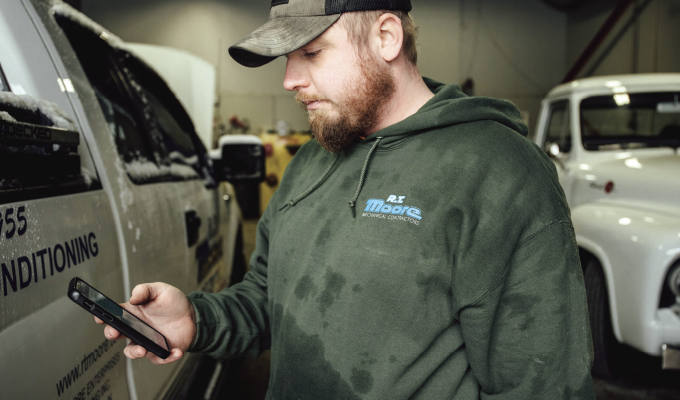While fleet solutions are great tools for improving both operations and cost control for companies managing fleet assets, there is an integral factor that often goes overlooked and can hamper successful implementation: driver adoption. Understanding driver hesitancy when it comes to adopting new solutions is the first step in addressing the issue to ensure a smoother integration process.
DRIVER DISCOMFORT
Fleet technologies, such as fleet management software (FMS) and telematics, are increasingly becoming a normal part of the daily routine for fleets industry wide. Despite the benefits these solutions offer, however, fleet drivers/operators may have concerns about its implementation. While these concerns differ from driver to driver, they are typically related to discomfort with technology, fear of the unknown, productivity loss, and invasion of privacy. To address these concerns effectively, fleet managers need to proactively engage with drivers before the purchasing process begins.
Unfortunately, while drivers are essential to any fleet’s success, oftentimes the decision-making process sidelines them, leading to a sense of hesitancy and low adoption rates. In addition to exclusion from the decision process, poor communication is a top contributor to poor driver adoption, as it does not provide transparency and context around why the decision was made, to what benefit, with what expectations, and so on.
CORE CONCERNS
Before adopting new technologies, fleet managers should initiate conversations with drivers to understand potential concerns and communicate the need for the fleet solution, as well as potential process changes and the expected benefits. This proactive approach not only aligns the solution with the fleet’s needs, it alleviates a majority of drivers’ concerns in one fell swoop.
For example, a primary concern is drivers’ discomfort with continuous monitoring, which can be perceived as intrusive, threatening both autonomy and privacy. By including drivers in the early stages of selecting a fleet solution, you demonstrate that their opinions are valued, easing discomfort with monitoring. Furthermore, seeking input, addressing concerns, and involving them in the software selection process empowers drivers to take ownership of the technology. This collaborative approach ensures that the chosen solution aligns with their needs, capabilities and, to some degree, their personal comfort. Plus, when their opinions and experiences are considered, drivers are more likely to embrace new technologies.
Another way to help alleviate privacy concerns is to communicate the technology’s purpose, emphasizing its benefits to both drivers and the business; focus on transparency and improved day-to-day operations, especially around productivity and how the solution is meant to make it easier for drivers to hit the ground running every day. But before fleet-wide implementation of any new technology, involve drivers in trials and/or product demonstrations to identify potential challenges. Gathering this feedback increases buy-in for the final decision, while also addressing the fear of the unknown concern.
TECH SKILL CONCERNS
Many drivers don’t feel confident in their skill level when it comes to technology, leading to frustration and hesitance. By accounting for all skill levels among your drivers, you’re more likely to choose a solution drivers are willing to use. Choosing a solution with an intuitive interface and simple authentication features minimizes the learning curve, boosting driver confidence. Since the goal of FMS and other fleet technologies is to improve processes, ease of use is basically essential, so prioritize solutions that offer simplicity without sacrificing functionality.
Offering thorough training during onboarding is another way to tackle usability concerns and ensure drivers are confident in using the solution’s features. Hands-on training sessions tailored to different skill levels and learning styles can help address knowledge gaps and build confidence. Providing drivers with easy-to-access resources, such as user manuals, video tutorials, FAQs, and digital help centers allows them to quickly find answers whenever challenges arise.
CONTINUED EDUCATION
Drivers are more likely to embrace technology when they understand its direct benefits, and highlighting such advantages as reduced paperwork, enhanced safety, simplified inspections, and improved communication can help drivers see how the technology makes their job a little easier. Once the solution is implemented, however, things can quickly change for any number of reasons, and with change comes hesitancy. Continuously monitoring software usage and gathering feedback allows fleets to address emerging challenges promptly and proactively refine onboarding and training based on driver input, creating an atmosphere of continuous improvement.
Speaking of continuous improvements, part of a good fleet solution’s security and usability is consistent updates. While not every update will change the user experience, adding new features and even just updated graphics can be jarring—especially when a driver has just perfected their routine within a new solution. To ease the potential frustrations this could cause, encourage open communication to address feedback early. Successful onboarding is an ongoing process, and creating a supportive culture can significantly influence driver attitudes toward technology adoption. An environment where drivers feel comfortable asking questions, sharing concerns, and seeking assistance contributes to a positive attitude toward technology.
CLOSING THOUGHT
Overcoming driver hesitancy is integral to harnessing the full potential—and benefits—of FMS and other fleet technologies. Understanding driver concerns related to monitoring discomfort, technology skills, and buy-in during decision-making requires a proactive approach. Prioritizing open communication, driver-input, training, and providing ongoing support, all contribute to creating an environment where drivers not only accept but embrace new technologies, ultimately leading to improved adoption and usage rates.

About the Author:
Rachael Plant is a content marketing specialist for Fleetio, a fleet management software company that helps organizations track, analyze and improve their fleet operations. For more info, visit fleetio.com.
Modern Contractor Solutions, December 2023
Did you enjoy this article?
Subscribe to the FREE Digital Edition of Modern Contractor Solutions magazine.



